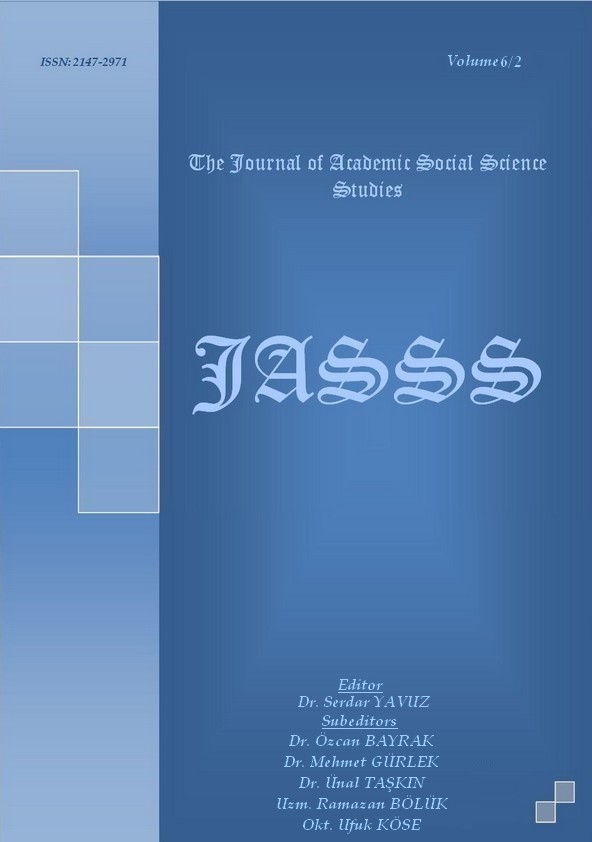Author :
Abstract
Biga yarımadası, Türkiye’nin kuzey batısında, kuzeyinde Marmara denizi, batısında Ege denizi ve güneyinde Edremit körfezi ile çevrili bir bölgedir. Anadolu'dan Çanakkale Boğazı yoluy¬la Avrupa yakasına geçiş güzergâhı üze-rinde bulunan Biga bölgesi bu özelliği sebebiyle tarihte önemli olaylara sahne olmuştur. Bu bölgede oluşturulan Biga sancağı, ilk dönemlerde Anadolu Eyaletine bağlı olup, bulunduğu coğrafi konum ve stratejik mevkii sebebiyle Rumeli'ye ve Batı Anadolu'ya hareket eden Osmanlı kuvvetlerinin toplanma ve geçiş yeri olmuştur. Bu çalışmada; Sultan Selim dönemine ait 5 Şubat 1516 tarihli Mufassal Tahrir Defteri, Biga Sancağı’nda yerleşim ve nüfus açısından incelenmiştir. Adıgeçen deftere göre Biga Sancağı, merkez Biga, Balya ve Avlonya, Çan, Ezine-Bazarı, Lâpseki ve Çatal-Bergos kazalarından oluşmuştur. Sancak genelinde 372 köy ve 100 mezra olup köylerden 44’ü boş, 15’i de harap durumdadır. Biga merkez 1077 hane, Bâlya ve Avlonya 1168 hane, Çan 432 hane, Ezine-Bazarı 1057 hane, Lâpseki ve Çatal Bergos 1251 hane, muaflar 534 hane olmak üzere toplam 5519 hane olup tahmini olarak 27595 kişilik nüfus yaşamaktadır. İncelenen deftere göre Biga ve nahiye merkezlerinde gayrimüslim mahalleleri yoktur. Kırsal kesimde ise değişik işlerle uğraşan gayrimüslim yerleşim yerleri ve cemaatler vardır. Sancak genelinde yaşayan gayrimüslimlerin genel sancak nüfusuna oranları % 1.5-2 civarındadır. Genellikle şehir merkezi veya kırsal kesimde yerleşim yerlerinin yakınlarına yerleşmiş, hayvancılıktan sınırlı tarıma kadar çeşitli işlerle uğraşan Yörük cemaatleri tespit edilmiştir. Bu cemaatler vakıf kayıtları hariç, Biga merkezde 103 hane, Biga kırsalında 32 hane, Balya’da 39 hane, Avlonya’da 32 hane, Ezine-Bazarı’nda 76 hane, 42 nefer olarak kaydedilmişlerdir.
Keywords
Abstract
Biga peninsula is region in the northwest of Turkey surrounded with Sea of Marmara in the north, Aegean Sea in the west and Gulf of Edremit in the south. As the region is situated at the passing route from Anatolia to Europea through Dardanelles, it experienced important events in the history. Sanjak of Biga which was founded in this region was under the control of Anatolia principality in the first several eras and was the passing and rally place for Ottoman troops moving to Rumelia and Western Anatolia thanks to its geographical and strategical position In this study, detailed Census Book dated February 5th 1516 that belonged to Sultan Selim period is analysed with relation to demographical features of Biga Province. According to the book, the Biga province is consisted of central Biga, Balya and Avlonya, Çan, Ezine-Bazarı, Lapseki and Çatal-Bergos towns. The Province includes 372 villages, 44 of which are deserted and 15 ruined, and 100 smaller settlement units. Biga is constituted of 5519 sections 1077 of which in the center, 1168 in Balya and Avlonya, 432 in Çan, 1057 in Ezine-Bazancı, 1251 in Lapseki and Çatal Bergos, 1251 in Muaflar and approximately a population of 27595 live in Biga. According to the Book, there were not any non-Muslim districts the core and peripheries of Biga. However, some non-Muslim communities and settlements existed in the rural outskirts. The overall non-Muslim population of the Province is considered to be around %1.5-2. Some Turkish nomadic communities were also detected living in the central regions and rural outskirts that had
